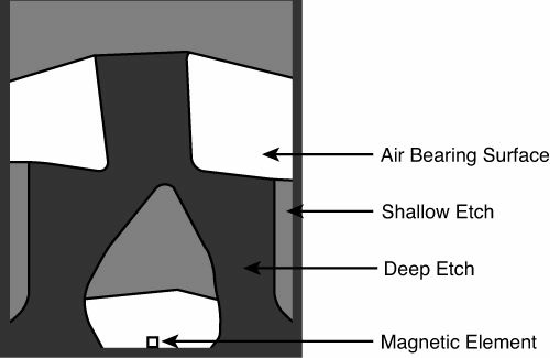Hardware Reference
In-Depth Information
Figure 8.9. Femto air-bearing slider surface design.
A Femto slider has three distinct areas with complex shapes designed to achieve a consistent head-to-
disk floating height across the disk as well as minimal height loss under high-altitude (low-pressure)
conditions. The shallow etch area creates a stepped air inlet allowing airflow to create a positive
pressure under the air-bearing surface that lifts the slider away from the disk. The deep etch area
creates an opposite negative pressure pocket that simultaneously pulls the slider closer to the disk
surface. The combination of positive and negative pressures is designed to balance the force of the
suspension arm pushing the slider toward the disk, while keeping the slider at the desired floating
height away from the disk surface. The balance of positive and negative pressures stabilizes and
reduces the floating height variations commonly found in older slider designs. The first drive using
the Femto slider design was the Hitachi 7K60 2 1/2-inch drive released in May 2003. Most of the
higher-capacity drives on the market today use this design.
Data-Encoding Schemes
Magnetic storage is essentially an analog medium. The data a PC stores on it, however, is digital
information—that is, 1s and 0s. When the drive sends digital information to a magnetic recording
head, the head creates magnetic domains on the storage medium with specific polarities
corresponding to the positive and negative voltages the drive applies to the head. The flux reversals
form the boundaries between the areas of positive and negative polarity that the drive controller uses
to encode the digital data onto the analog medium. During a read operation, each flux reversal the
drive detects generates a positive or negative pulse that the device uses to reconstruct the original
binary data.
To optimize the placement of flux transitions during magnetic storage, the drive passes the raw digital
input data through a device called an encoder/decoder (endec), which converts the raw binary
information to a waveform designed to optimally place the flux transitions (pulses) on the media.
During a read operation, the endec reverses the process and decodes the pulse train back into the
original binary data. Over the years, several schemes for encoding data in this manner have been
developed; some are better or more efficient than others, which you see later in this section.
Other descriptions of the data-encoding process might be much simpler, but they omit the facts that

